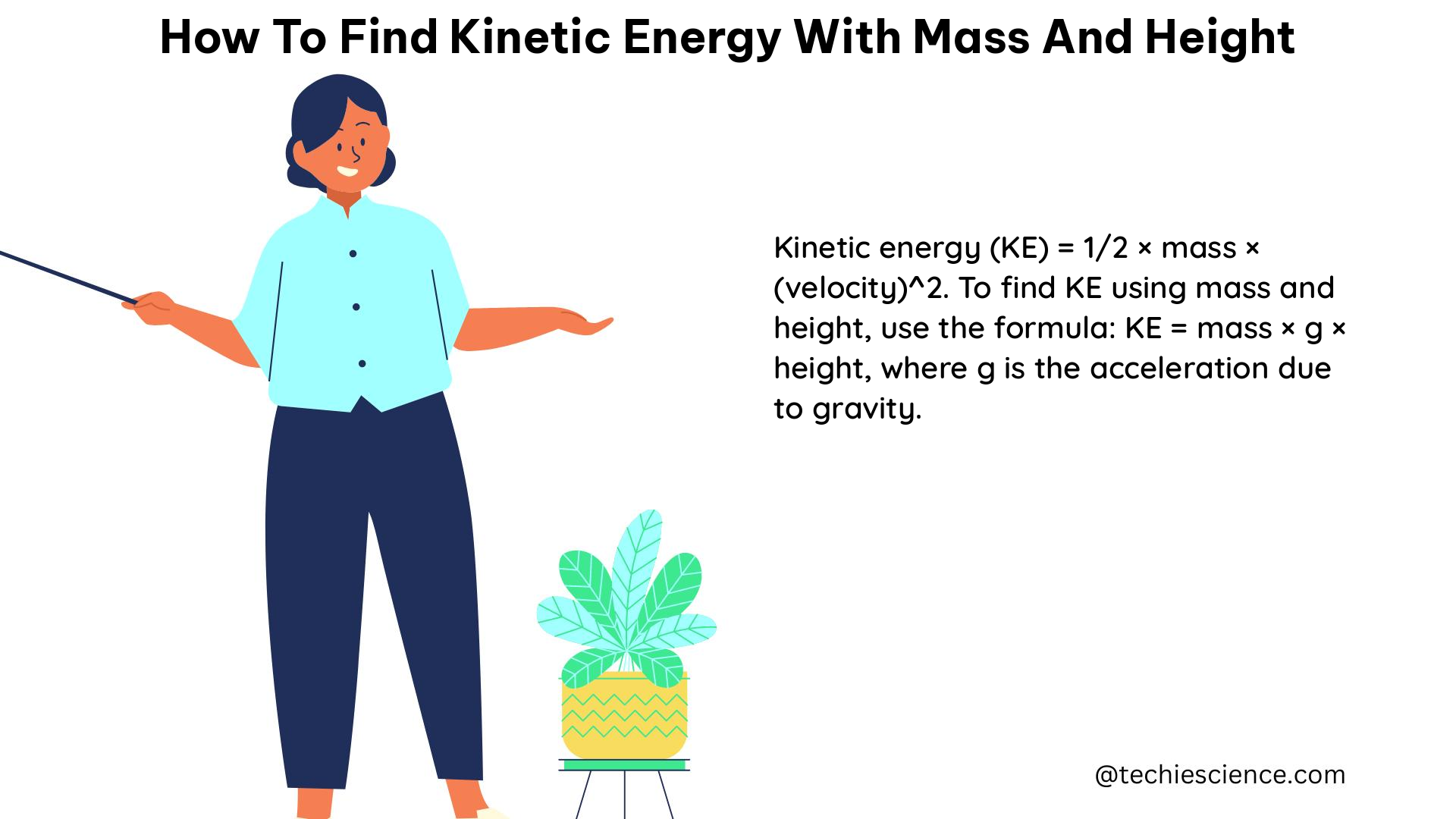Kinetic energy is a fundamental concept in physics that describes the energy of motion. To calculate the kinetic energy of an object, you need to know its mass and velocity. However, in some cases, you may only have the object’s mass and height, rather than its velocity. In this comprehensive guide, we’ll explore the step-by-step process of finding the kinetic energy of an object using its mass and height.
Understanding the Relationship between Kinetic Energy, Potential Energy, and Velocity
Kinetic energy (KE) is the energy an object possesses due to its motion and is calculated using the formula:
KE = 1/2 × m × v^2
Where:
– m is the mass of the object
– v is the velocity of the object
Potential energy (PE), on the other hand, is the energy an object possesses due to its position or configuration. The formula for potential energy is:
PE = m × g × h
Where:
– m is the mass of the object
– g is the acceleration due to gravity (9.8 m/s^2 on Earth)
– h is the height of the object
To find the kinetic energy of an object using its mass and height, we need to first determine the velocity of the object. We can do this by using the equation of motion:
v = √(2 × g × h)
Where:
– v is the velocity of the object
– g is the acceleration due to gravity
– h is the height of the object
Calculating Kinetic Energy from Mass and Height

Now that we have the formula for finding the velocity of an object using its mass and height, we can substitute this into the kinetic energy formula to get the final result.
The steps are as follows:
- Determine the mass (m) of the object.
- Determine the height (h) of the object.
- Calculate the velocity (v) of the object using the equation of motion:
v = √(2 × g × h) - Substitute the values into the kinetic energy formula:
KE = 1/2 × m × v^2
KE = 1/2 × m × (2 × g × h)
KE = m × g × h
Therefore, the kinetic energy of an object with mass (m) and height (h) is equal to the mass of the object multiplied by the acceleration due to gravity and the height of the object.
Example Calculation
Let’s consider an example to illustrate the process.
Suppose we have a ball with a mass of 0.5 kg, and it is dropped from a height of 10 meters. We want to find the kinetic energy of the ball just before it hits the ground.
- Mass (m) = 0.5 kg
- Height (h) = 10 m
- Velocity (v) = √(2 × g × h)
v = √(2 × 9.8 m/s^2 × 10 m)
v = 14 m/s - Kinetic Energy (KE) = m × g × h
KE = 0.5 kg × 9.8 m/s^2 × 10 m
KE = 49 J
Therefore, the kinetic energy of the ball just before it hits the ground is 49 Joules.
Additional Considerations and Factors
- The formula for kinetic energy with mass and height is only valid for objects that are in free fall, where the only force acting on the object is the force of gravity.
- If the object is moving horizontally or has additional forces acting on it, the formula may need to be modified to account for these factors.
- The acceleration due to gravity (g) can vary slightly depending on the location on Earth, so it’s important to use the appropriate value for the specific location.
- In some cases, you may need to consider air resistance or other environmental factors that can affect the object’s motion and kinetic energy.
Conclusion
Calculating the kinetic energy of an object using its mass and height is a useful skill in physics and engineering. By understanding the relationship between kinetic energy, potential energy, and velocity, you can apply the appropriate formulas to solve a variety of problems involving moving objects. This guide has provided a comprehensive overview of the process, including step-by-step instructions, example calculations, and additional considerations. With this knowledge, you’ll be well-equipped to tackle kinetic energy problems involving mass and height.
Reference:
- Teaching kinetic energy as an observable quantity – IOPscience
- Practice applying velocity and energy formulas – Study.com
- Kinetic Energy Calculator – CalculatorSoup.com

The lambdageeks.com Core SME Team is a group of experienced subject matter experts from diverse scientific and technical fields including Physics, Chemistry, Technology,Electronics & Electrical Engineering, Automotive, Mechanical Engineering. Our team collaborates to create high-quality, well-researched articles on a wide range of science and technology topics for the lambdageeks.com website.
All Our Senior SME are having more than 7 Years of experience in the respective fields . They are either Working Industry Professionals or assocaited With different Universities. Refer Our Authors Page to get to know About our Core SMEs.